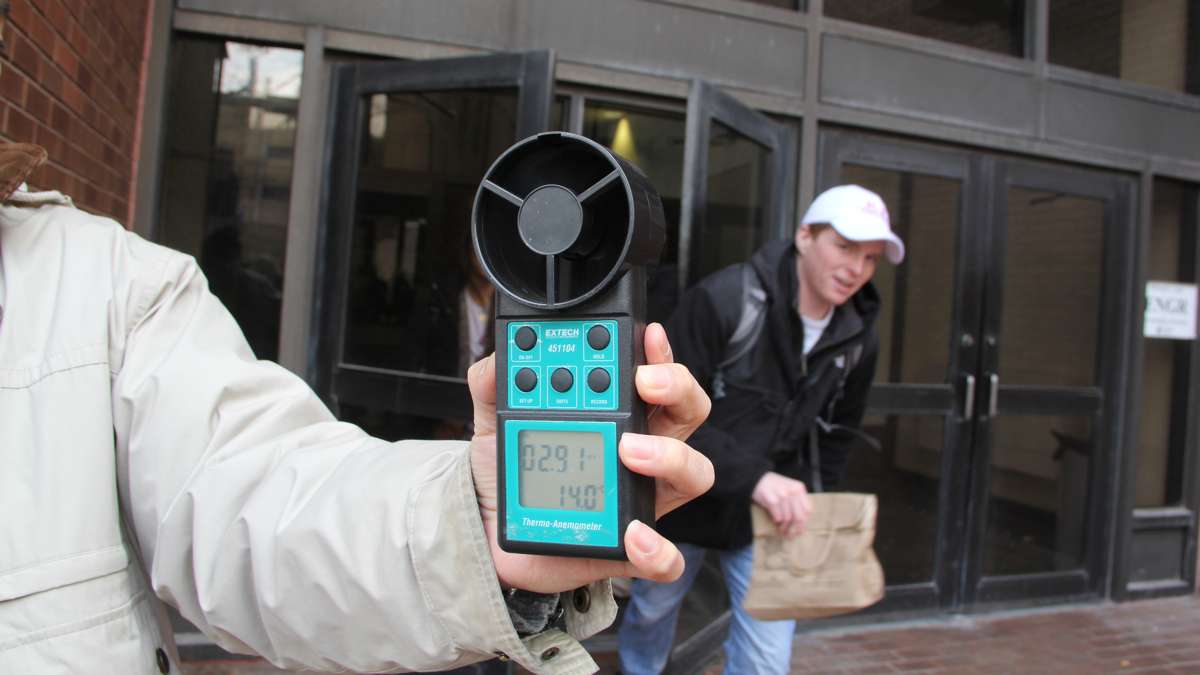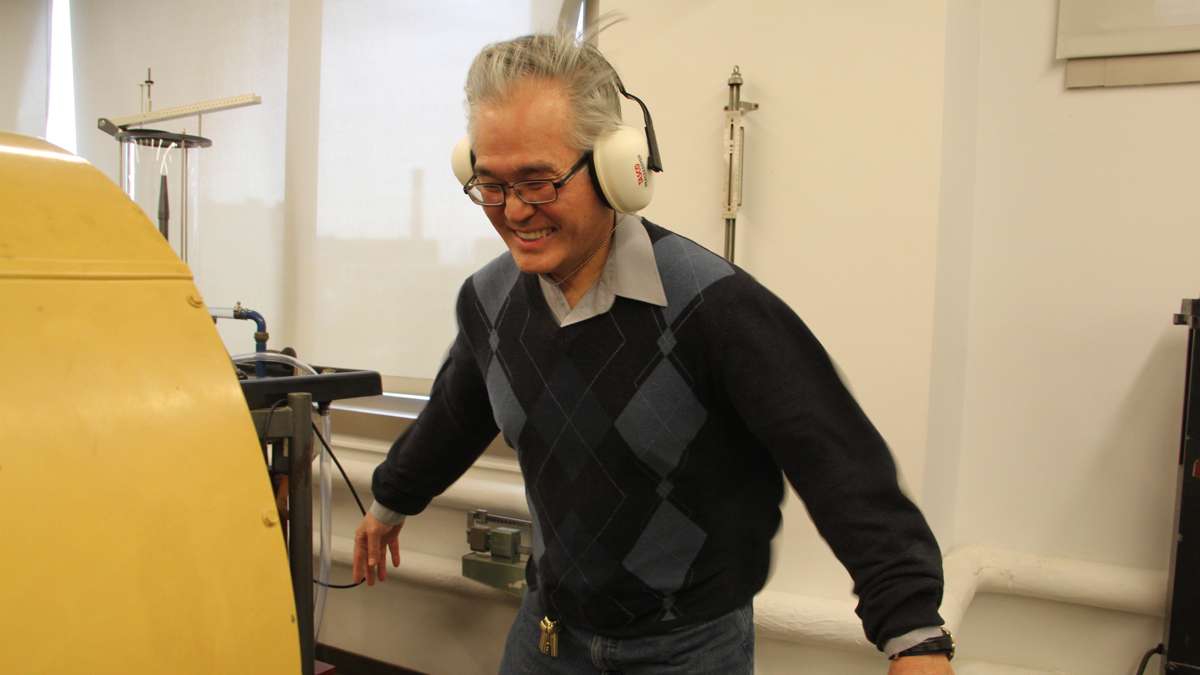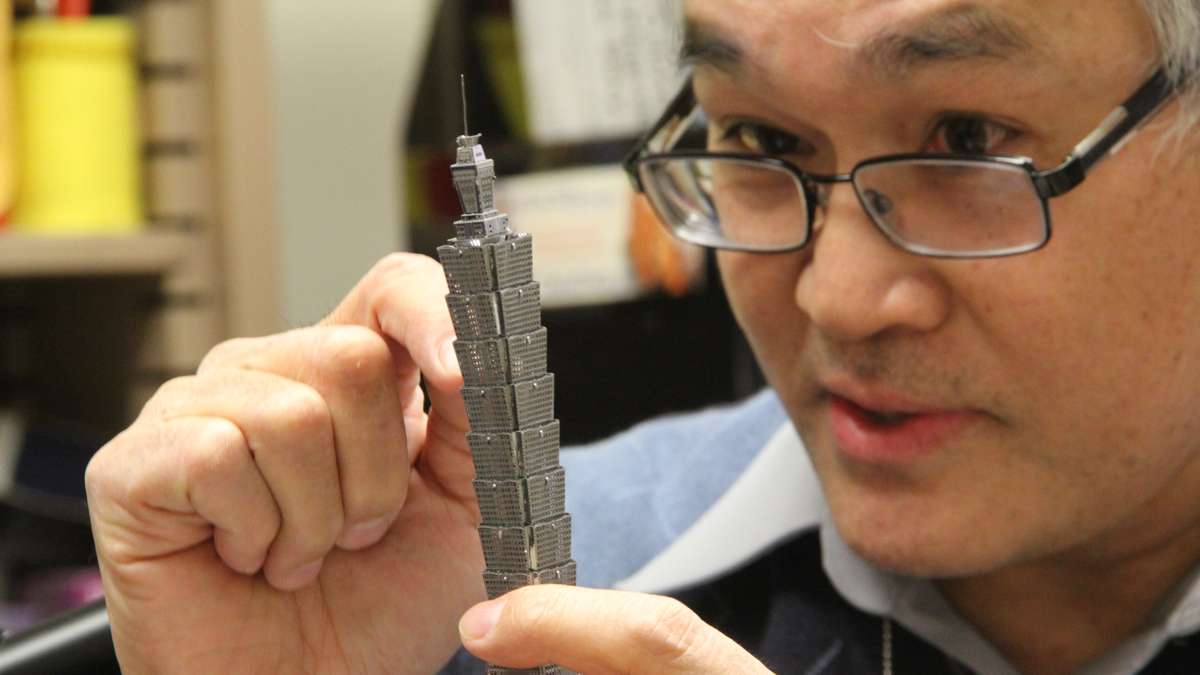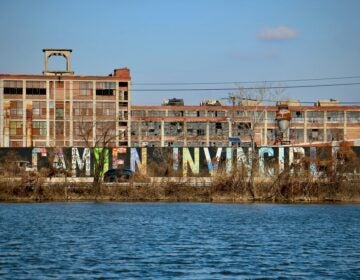The science of wind tunnels – where and why those harsh winds strike
Listen 4:24-

A Temple graduate student uses an anemometer to take a wind reading outside Temple's College of Engineering. (Emma Lee/WHYY)
-

Jim Chen, professor of engineering at Temple, takes a blast from a small wind tunnel at the College of Engineering. (Emma Lee/WHYY)
-

Temple Professor Jim Chen, who specializes in aerodynamics, explains how designers can defeat the wind using a model of Taipei World Financial Center, one of the world's tallest buildings. (Emma Lee/WHYY)
You may have noticed while walking through Philadelphia that certain spots are windier than others – so much so, that in a split second you feel like you’re going to be blown off your feet. It’s something commonly referred to as the wind tunnel effect.
“[It] doesn’t bother me too much, but it can be a bit obnoxious,” Temple University student Josh Boden said, while walking between Morgan Hall North and Morgan Hall South on Temple’s campus.
Morgan Hall North is 27 stories high. Morgan Hall South is 10 stories high. The two residence halls form a rectangle with two upward, narrow passageways at opposite corners. This spot is notorious among students because of the whipping winds that hit them.
“Just trying to fight the winds is like a cartoon. That’s pretty much how I feel when I’m walking through here,” Temple student Jennifer Kullgren said.
Fighting the winds is exactly what you’re doing. Many students find themselves leaning forward in order to make their way up the passageways. The winter air feels much colder in wind tunnels. The skin on your face often goes numb and your eyes swell up with water.
“It’s a real effort to just get to my dorm walking uphill through the wind. Definitely questioning the architecture behind these buildings,” Temple student Owen McCue said.
The architecture and engineering of the buildings explain it all.
The ‘why’ behind wind tunnels
The wind tunnel effect happens when wind encounters a tall rectangular building. After the wind hits the building, it changes direction.
“They are going to go in all directions,” Jim Chen, mechanical engineering professor at Temple, said. “Usually it will go in the direction with least resistance. So the air will come down. And the pedestrian will feel the high wind.”
That downward motion of air is called downwash. The downwash can be felt most prominently around the building’s corners because that is a region with high suction.
“Some people think they can hide around the corners…actually the corners may be more dangerous. The wind speed can double around the corners,” Chen said.
The wind tunnel effect can be felt flowing between two tall buildings as well, as is the case with the two residence halls. The closer proximity creates a smaller space for wind to travel. Therefore, the air pressure drops, causing the wind to move faster and circle between the two buildings.
Today, we have innovative building designs, such as more circular skyscrapers that allow the wind to move around them more easily, to reduce the discomfort pedestrians feel from the wind.
How design can prevent wind tunnels
But why haven’t we started implementing these designs in Philly?
One answer: money.
“Architects love to respond to and articulate a lot of conditions in designing a building, but you have to decide which conditions are most important,” Robert Shuman, architect at the Tyler School of Art at Temple University, said.
Turns out, the architect doesn’t decide what’s important. The person or corporation paying for the project does. Determining the wind effects on pedestrians is usually something that doesn’t rank very high on their list.
“Lots of times, if you ask an owner do they want to pay 30 or 40 thousand dollars or 50 thousand dollars for that sort of analysis, which can be done, there’s a very limited number of people who do it. Usually the answer is no,” Shuman said.
The city’s building code doesn’t require a wind study to be done to determine ground level wind turbulence. That’s because it isn’t considered a life safety issue. This makes it difficult for the design team to persuade the person paying that they should have the wind effects of their building analyzed.
“It’s very hard to go back to an owner and tell them that they need to shorten their building by six stories because on some days of the year, there might be some discomfort in some places,” Shuman said.
Philadelphia vs. other cities
Luckily, the problem isn’t as bad in Philadelphia as it is in other major cities.
“Philadelphia is a low-rise city,” Joseph P. Martin, civil, architectural and environmental engineering professor at Drexel University, said. “Most of the city is row houses, so they’re not going more than 40 to 50 feet above the ground.”
Buildings have to be at least 250 feet – or 20 stories – above the ground for the effect to happen, according to Chen. It also helps if the city is on the windier side, which Philly is not. Surprisingly, experts don’t think Chicago is the place with the biggest wind tunnel problem.
“Probably Boston,” Martin said. “Highest average winds are starting from that point. And the Charles River on the West is wide enough that it affects and makes wind come in one side to the other. And the streets are very narrow. The narrower the streets, the more this happens.”
Overall, Boston averages wind speeds of 12.3 miles. That’s the highest average annual wind speed of all the windiest major cities. Contributing to the city’s wind speed is the jet stream that hits Boston with north westerly winds most of the time. Another factor is the cooler air over the sea being pushed toward land. This “sea breeze” is more common in Boston than it is in Philadelphia because wider bodies of water surround Boston.
Still, it’s pretty lousy getting trapped in the wind tunnels here.
My wind tunnel is on Temple’s campus between Morgan Hall North and South. Where’s your wind tunnel? Do you think your wind tunnel triumphs over all other wind tunnels? Or do you think there’s a city with worse wind tunnels than Boston? Let us know in the comment section below.
WHYY is your source for fact-based, in-depth journalism and information. As a nonprofit organization, we rely on financial support from readers like you. Please give today.






